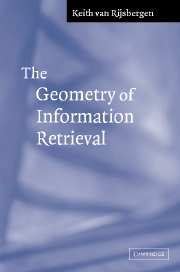Book contents
- Frontmatter
- Contents
- Preface
- Prologue
- 1 Introduction
- 2 On sets and kinds for IR
- 3 Vector and Hilbert spaces
- 4 Linear transformations, operators and matrices
- 5 Conditional logic in IR
- 6 The geometry of IR
- Appendix I Linear algebra
- Appendix II Quantum mechanics
- Appendix III Probability
- Bibliography
- Author index
- Index
1 - Introduction
Published online by Cambridge University Press: 14 January 2010
- Frontmatter
- Contents
- Preface
- Prologue
- 1 Introduction
- 2 On sets and kinds for IR
- 3 Vector and Hilbert spaces
- 4 Linear transformations, operators and matrices
- 5 Conditional logic in IR
- 6 The geometry of IR
- Appendix I Linear algebra
- Appendix II Quantum mechanics
- Appendix III Probability
- Bibliography
- Author index
- Index
Summary
This book is about underlying ideas and theory. It is about a way of looking, and it is about a formal language that can be used to describe the objects and processes in Information Retrieval. It is not about yet another model for IR, although perhaps some will want to find such an interpretation in it.
Why do we need another way of looking at things? There are some good reasons. Firstly, although there are several IR models, for example vector space, probabilistic, logical to name the most important, they cannot be discussed within a single framework. This book, The Geometry of Information Retrieval (GIR), is a first attempt to construct a unifying framework. Secondly, although many of us pay lip-service to the conceptual depth of some of the fundamental notions in IR such as relevance, we rarely analyse these notions formally to any bedrock. This is not because we are lazy, it is rather because our theoretical tools have made it very difficult to do so. What follows will, it is hoped, aid such formal analysis. And thirdly, there is a need to support the formal specification or expression of IR processes so that we can formally reason about them. For example, we need to be able to lay down mathematical constructs that will direct us in the design of some new algorithms for IR. This is especially important if we wish to extend the boundaries of current research.
- Type
- Chapter
- Information
- The Geometry of Information Retrieval , pp. 15 - 27Publisher: Cambridge University PressPrint publication year: 2004
- 1
- Cited by

